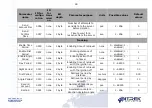
24
+380 44 507 02 07
volatile memory.
If a number of a card being read matches one of the card numbers
saved to the memory, the device activates one of the discrete outputs.
Network addresses 3, 9, and 10 are reserved for operation with
RFID readers. They cannot be changed, which is why a reader must be
configured with one of these addresses to operate correctly.
Configuring the Device for Operation with Fuel Meter
RS-485
The BI-810 TREK Tracking Device is compatible with fuel meter
supporting RS-485 bus. In total, up to four fuel meters can be connected.
Respective I/O component must be enabled in the configuration
settings of the device.
Besides, the fuel meters must be pre-configured with respective
network address. Network addresses 1, 2, 5, and 6 are reserved on the
BI-810 TREK Tracking Device for operation with fuel meters.
The tracking device has a feature of transmitting unprocessed
(raw) data from the level meters, as well as the data processed with
Kalman filter. Optimal filtration factors for Kalman filter are set by
default.
Filtered and non-filtered values are transmitted by different I/O
components.
Moreover, if the level meters are equipped with an in-built
temperature sensor, data from it can be retrieved and transmitted to a
server.
Also, when fuel level meters are used on special machinery with
GND conductor that can be switched off, a situation may occur when fuel
level readings are reset to zero if the chassis GND conductor is switched
off, which results in false fuel level drop being registered in the
monitoring software. In order to avoid this situation, the ID=0819
parameter must be enabled, which is disabled by default.
Enabling the use of values of the last valid fuel level:
setparam 0819 1;
If the cable length from the fuel meter to the tracker is over 12
meters, which, ultimately, results in failure to transmit the data from the
sensor, the device circuit board has jumper No.1 (Figure 7) that is
intended for enabling pull-up resistor and 'А' & 'В' lines conditioning.
Switch No.2 is not used.
Fig. 7. Line Conditioning Jumper
















































